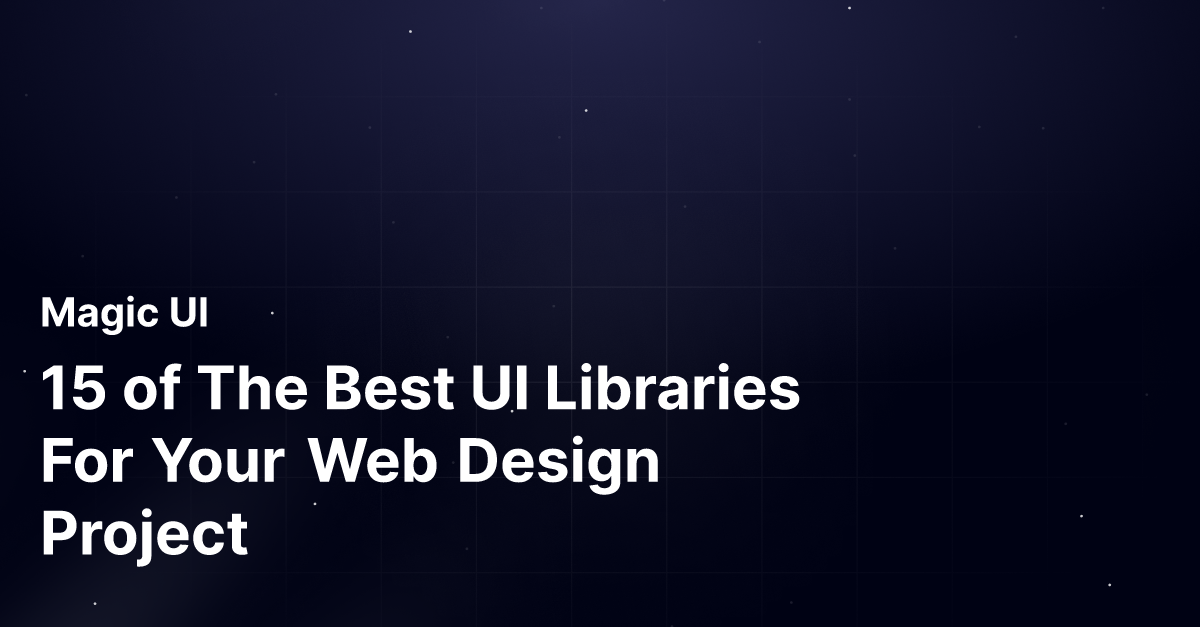Consider you're working on a website project, and you've fine-tuned your goals, nailed your target audience, and mapped out the pages you'll need. But as you begin the actual web design process, you realize your site could benefit from a few extra features. To achieve these goals, you'll need to incorporate additional user interface components, and that's where UI libraries come in.
These collections of pre-designed UI elements can help you quickly enhance your site with visually appealing, customizable modules that will improve your website's usability and overall user experience. This guide will introduce you to 15 UI libraries and provide insight into the web design best practices for your project.
MagicUI's startup landing page template can help you start with UI libraries immediately. This fully responsive template includes various customizable UI components you can easily mix and match to achieve your design goals.
The Power of UI Libraries in Web Design

UI libraries have transformed web development, offering pre-built components, design systems, and styling tools that streamline development. By leveraging these libraries, developers can create visually appealing and consistent user interfaces more efficiently.
Key Benefits of Using UI Libraries
Increased Efficiency
Pre-built components reduce development time and effort, allowing developers to focus on core functionalities rather than reinventing the wheel.
Improved Consistency
Adherence to a defined design system ensures a cohesive user experience across different pages and components, enhancing brand recognition and user satisfaction.
Enhanced Accessibility
Many UI libraries prioritize accessibility standards, making websites more inclusive for users with disabilities and improving overall user experience.
Faster Time-to-Market
Rapid prototyping and development, enabled by UI libraries, lead to faster product launches and increased time-to-market.
Incorporating MagicUI into Your Project
MagicUI is a versatile UI library that offers a collection of animated components designed specifically for design engineers. Its integration into your web design project can provide several advantages:
Streamlined Development
The pre-built components and design system accelerate development, allowing you to build complex user interfaces more efficiently.
Enhanced Visual Appeal
Animated components add visual interest and engagement to your website, making it more captivating and memorable for users.
Customization Options
MagicUI offers flexibility for tailoring components to match your brand's style and preferences, ensuring a cohesive and personalized user experience.
Accessibility Focus
The library adheres to accessibility standards, making your website more inclusive for users with disabilities and improving overall user experience.
Additional Considerations
Framework Compatibility
Ensure that MagicUI is compatible with your chosen frontend framework (React, Vue, Angular, etc.) to avoid compatibility issues and ensure smooth integration.
Learning Curve
Familiarize yourself with MagicUI's documentation and API to effectively utilize its features and customize components to your specific needs.
Community Support
Consider the size and activity of MagicUI's community for resources, assistance, and potential contributions.
By incorporating MagicUI into your web design project, you can create visually stunning and user-friendly interfaces while saving time and effort. The library's pre-built components, animation capabilities, and customization options make it a valuable tool for designers and developers seeking to build exceptional web experiences.
Related Reading
- Web Application Design
- How To Make An Interactive Website
- Best Web Design Tools
- Website Animation Examples
- Web Design Trends
- Text Animation CSS
- UI Animation
Top 15 UI Libraries

1. Material-UI (MUI): Customizable Components for Your New React App
Material-UI, or MUI, is a popular React component library based on Google's Material Design principles. Material-UI offers developers a comprehensive suite of customizable components for building modern, responsive user interfaces. With its extensive component library, customizable themes and styles, accessibility support, and strong community, Material-UI is a versatile choice for developers looking to streamline their web development process and create visually appealing applications.
2. Tailwind CSS: Utility Classes for Building Custom Designs
Tailwind CSS is a utility-first CSS framework that provides predefined utility classes for building custom and responsive designs without writing CSS from scratch. By combining these classes, developers can create unique and visually appealing styles without extensive CSS knowledge. Tailwind CSS offers flexibility, customization, and integration with popular frameworks, making it a popular choice for developers seeking a more efficient and streamlined approach to CSS development.
3. Ant Design: A Design System for Enterprise Applications
Ant Design is a system for enterprise-grade applications that offers a comprehensive set of components focusing on usability and performance. With its extensive component library, internationalization support, accessibility compliance, and high-quality design and documentation, Ant Design is well-suited for building large-scale applications that require a robust and reliable UI framework.
4. Chakra UI: Create Accessible and Maintainable React Applications
Chakra UI is a modular and accessible UI library for building accessible and maintainable React applications. With its themeable components, accessibility-focused design, strong community, and integration with other popular libraries, Chakra UI provides developers a flexible and efficient way to create accessible and visually appealing user interfaces.
5. Bootstrap: The Most Popular Front-End Framework
Bootstrap is a popular HTML, CSS, and JavaScript framework for building responsive websites and applications. With its grid system, pre-built components, responsive design support, and large and active community, Bootstrap offers developers a comprehensive set of tools for creating modern and responsive web interfaces.
6. Semantic UI React: A Human-Friendly Approach to Building UIs
Semantic UI React is a React component library based on Semantic UI, offering a human-friendly interface for building responsive web applications. With its human-readable class names, customizable components, responsive design support, and strong community, Semantic UI React provides developers with a more intuitive and efficient way to build web interfaces.
7. Mantine: A Performance-Focused React Component Library
Mantine is a React component library focused on performance, accessibility, and developer experience. With its customizable themes and styles, accessibility support, performance optimization, and integration with other popular libraries, Mantine provides developers a high-quality and efficient UI library for building modern web applications.
8. PrimeReact: A UI Library for Enterprise Applications
PrimeReact is a React UI component library designed for enterprise-grade applications, offering a comprehensive set of components and features. With its extensive component library, performance optimization, accessibility support, and integration with other popular libraries, PrimeReact is a reliable choice for building large-scale and complex web applications.
9. Blueprint UI: A Library for Complex Data-Rich Applications
Blueprint UI is a React component library designed for building complex data-rich applications. With its data visualization components, form components, responsive design support, and strong community, Blueprint UI provides developers the tools they need to create efficient and informative data-driven interfaces.
10. Bulma: A Modern CSS Framework
Bulma is a modern CSS framework for building responsive websites and applications. With its grid system, pre-built components, responsive design support, and large and active community, Bulma offers a flexible and efficient way to create visually appealing and responsive web interfaces.
11. Onsen UI: Create Hybrid Mobile Apps with Web Technologies
Onsen UI is a hybrid mobile app UI framework that allows you to build native-like apps using web technologies. With its cross-platform compatibility, pre-built components, performance optimization, and integration with popular frameworks, Onsen UI provides developers a powerful tool for creating high-quality mobile applications.
12. Vuetify: A Material Design Component Library for Vue.js
Vuetify is a Vue.js UI component library offering a comprehensive set of components for building modern and responsive web applications. With its extensive component library, customizable themes and styles, accessibility support, and strong community, Vuetify provides developers a flexible and efficient way to build visually appealing Vue.js applications.
13. Nuxt.js: A Framework for Building Server-Rendered Vue.js Applications
Nuxt.js is a framework for building server-rendered Vue.js applications, offering a set of pre-built components and features for efficient development. With its server-side rendering, pre-built components, performance optimization, and integration with other popular libraries, Nuxt.js provides developers with a powerful tool for building fast and scalable Vue.js applications.
14. Next.js: A Framework for Building Server-Rendered React Applications
Next.js is a React framework for building server-rendered React applications, offering a set of pre-built components and features for efficient development. With its server-side rendering, pre-built components, performance optimization, and integration with other popular libraries, Next.js provides developers with a powerful tool for building fast and scalable React applications.
15. Quasar Framework: A Framework for Building Cross-Platform Applications
Quasar Framework is a cross-platform framework for building web, mobile, and desktop applications using Vue.js. With its cross-platform compatibility, pre-built components, performance optimization, and integration with other popular libraries, Quasar Framework provides developers a versatile and efficient way to build applications running on multiple platforms.
Choosing the Right UI Library

Framework Compatibility: Ensuring Smooth Integration with Your Frontend Framework
Choosing a UI library compatible with your frontend framework ensures smooth integration and avoids costly compatibility issues. First, ensure the library works with your framework (React, Vue, Angular, etc.). Then, assess the documentation and community resources available for the library within your framework. Finally, consider how easily the library will integrate with your existing code structure and dependencies. If you are starting a new project, choosing a different UI library may be worthwhile to avoid future headaches.
Design Style: Matching Visual Directions
Every web design project has a visual direction that must be reflected in your chosen UI components. For this reason, it’s crucial to evaluate a library’s design style before selecting it. Aim for a library with a visual aesthetic that aligns with your project’s overarching goals. This will help create a cohesive and appealing user experience.
You should also consider how customizable the components are to ensure you can tweak their appearances to match your brand’s unique style. Finally, assess the library’s theming capabilities to ensure you can modify the overall look and feel of the UI to match your project’s requirements.
Feature Set: Ensuring the Library Meets Your Project Needs
Not all UI libraries are created equal. The features and components they offer can vary significantly from library to library. For this reason, it is essential to evaluate a library’s feature set before making your selection. Start by assessing the component library to ensure it has all the elements for your project.
Next, consider additional features the library may offer, such as accessibility support, performance optimization, theming, and integration with other popular libraries. Finally, prioritize the most essential features for your project and select a library that covers them.
Community and Support: Prioritizing a Well-Supported Library
A UI library is only as good as the community that supports it. Before selecting, evaluate the library’s community size and activity to ensure ample resources and support are available when needed. Next, consider the library’s documentation quality and any available learning resources.
A well-documented library with comprehensive learning resources can make it easier to learn and use. Finally, community engagement in forums and discussion groups should be assessed, as this can indicate the quality of support available.
Ease of Customization: Flexibility is Key
One of the most significant advantages of using a UI library is the ability to customize it to fit your project’s unique requirements. For this reason, you’ll want to select a library that allows plenty of flexibility and customization to ensure you can tailor its components to your specific design needs.
Start by evaluating the library’s overall flexibility and customization options. Next, assess its theming capabilities and support for custom styling. Finally, consider the ability to modify individual components to ensure you can create the perfect design for your project.
Performance: Ensuring Your Library is Optimized
Using an extensive UI library can impact your web application’s performance—especially if you’re building a complex or enterprise-level project. For this reason, it’s vital to assess your library’s performance before and after implementation. Start by evaluating the library’s performance impact on your web application.
Next, look for optimization efforts or performance benchmarks to ensure the library meets your project’s performance requirements. Finally, conduct your performance tests in your specific use case to identify potential issues before they impact your users.
How MagicUI Helps You Design Interactive Websites
MagicUI creates interactive websites that are rich with animations and transitions. This open-source library offers over 20 animated components specifically for React applications. Each element is built with TypeScript, Tailwind CSS, and Framer Motion to ensure a smooth, customizable, and visually appealing user experience. With MagicUI, I can create engaging websites that impress visitors and keep them returning.
Bring Any Design to Life with MagicUI
Each component in MagicUI comes with built-in animations that help bring websites to life. You can use these interactive elements to create a more engaging user experience for your web applications. Instead of jumping from page to page, users can interact with your website and enjoy visually appealing transitions, making your application feel more like a game and less like a boring old website.
Choosing the Right UI Library for Your Web Design Project
Framework Compatibility: The Crucial First Step
Selecting the proper UI library for your web design project is crucial to ensuring a successful and efficient development process. Several factors should be considered when making this decision:
- The first step is to ensure compatibility. The UI library should be compatible with your frontend framework (React, Vue, Angular, etc.) to avoid compatibility issues and ensure smooth integration.
- Next, consider support. Evaluate the library's level of support for your specific framework, including documentation, community resources, and updates.
- Finally, assess integration ease. Consider how seamlessly the library integrates with your existing project structure and dependencies.
Design Style and Preferences: What Do You Want It to Look Like?
Next, you'll want to match your project's visual direction. The library's design style should align with your project's overall visual direction to create a cohesive and visually appealing user experience.
Also, consider customization. Evaluate the library's flexibility for customization, allowing you to tailor components to match your brand's unique style and preferences. It's also wise to assess the ability. Consider the library's theming capabilities and support for custom styling to modify your application's overall appearance quickly.
Feature Set: What Does the Library Offer?
Like a car, not all UI libraries are created equal. Some perform better than others, and some have features better suited to your specific needs. You'll want to evaluate the component library to determine if it offers the necessary components for your project.
Also, consider additional features. Evaluate the library's extra features, such as theming, accessibility support, performance optimization, and integration with other popular libraries. Finally, prioritize essential features. Determine which features are most important for your project and select a library that offers those features.
Community and Support: You'll Want Some Backup
If you run into trouble using a library, knowing someone else has solved the problem or can help you figure it out is excellent. So, research community size. Evaluate the size and activity of the library's community to assess the availability of resources, support, and potential contributions.
Next, consider documentation and learning resources. A well-documented library with comprehensive learning resources can make it easier to learn and use. Finally, evaluate community engagement. Consider the level of engagement and responsiveness within the community, as this can indicate the quality of support available.
Ease of Customization: Can You Make It Your Own?
Off the shelf UI components are great, but they rarely fit your project’s needs right out of the box. So, you'll want to evaluate flexibility. Consider the library's flexibility for customization, allowing you to tailor components to match your project's specific requirements and branding.
Next, assess theming capabilities. Evaluate the library's theming capabilities and support for custom styling to modify your application's overall appearance quickly. Finally, consider component customization. Evaluate the library's ability to customize components to meet your design needs.
Performance: How Fast Will It Go?
Just like a car, some UI libraries perform better than others. You'll want to consider performance impact when evaluating a library's performance impact on your web application, especially for large or complex projects.
Next, assess optimization efforts. Consider the library's optimization efforts and performance benchmarks to ensure it meets your project's performance requirements—finally, test performance in your specific use case. Conduct performance tests to evaluate the library's performance in your project's specific context.
Related Reading
- Cool CSS Animations
- Web Animation Tools
- Animation Libraries
- React Animation Examples
- Framer Motion React
- React Animations
- React Text Animation
- React Scroll
- MUI Transitions
- React Spring
10 Best Practices for Implementing UI Libraries
1. Understand Your Project Requirements: Define Your Goals
Before using a UI library, you must define your project's goals. What are you trying to achieve? Who are you building it for? What are their needs and preferences? What are your design standards? Next, assess the specific features and components you need from a UI library to achieve your unique objectives. Finally, consider your project's complexity and the customization level required. The answers to these questions will help you narrow your options and select the best UI library for your project.
2. Research and Evaluate UI Libraries: Find the Perfect Fit
Once you understand your project requirements, it’s time to research UI libraries that fit your needs. Start by identifying potential candidates based on your specifications and framework compatibility. Next, evaluate each library's features, documentation, community support, and performance. Also, consider factors like design style, ease of use, and customization options. Doing your homework will pay off in the long run and help you avoid headaches.
3. Start with a Small-Scale Implementation: Avoid Unnecessary Headaches
Once you settle on a UI library, resist the urge to dive into your project’s codebase and implement many components simultaneously. Instead, start with a small-scale implementation. Begin by implementing a few components from the chosen library in a small-scale project or prototype. This will allow you to evaluate the library's performance, integration, and compatibility with your existing codebase. You’ll also identify potential challenges or limitations before they become more significant issues that slow your project down.
4. Follow Best Practices for Component Usage: Keep It Clean
As you implement UI components into your project, follow best practices for their usage. Adhere to the library's recommended usage guidelines. Use components as intended and avoid unnecessary modifications that could introduce bugs. Leverage the library's built-in features and customization options to keep your code clean and efficient.
5. Prioritize Accessibility: Don’t Forget the Basics
When it comes to web design, accessibility should always be a top priority. This is especially true when implementing a UI library. Start by ensuring that the library you choose supports accessibility standards. Next, use ARIA attributes and semantic HTML elements to make your components accessible to users with disabilities. Finally, test your application with assistive technologies to identify and address accessibility issues.
6. Consider Performance Optimization: Don’t Let the Library Drag You Down
UI libraries can introduce a fair amount of code to your application. This can hurt your site’s performance, especially when using a large or complex library. Before implementing a UI library, evaluate the potential performance impact on your web application. Next, optimize component usage and reduce unnecessary rendering. Finally, leverage performance-enhancing techniques like lazy loading and code splitting to improve your application’s performance.
7. Maintain Consistency and Branding: Make It Your Own
While UI libraries can give your project a polished look, it’s important to customize them to fit your unique design requirements. Start by adhering to your project's design guidelines and branding standards. Next, customize the UI library's components to match your brand's visual identity. Finally, ensure consistency across different parts of your application to create a cohesive user experience.
8. Leverage the Community and Documentation: Don’t Go It Alone
One of the most significant benefits of using UI libraries is the resources available to help you. Take advantage of the library's community forums and documentation for support and guidance. Seek help from other developers who have experience using the library. Finally, stay updated with the latest releases and improvements.
9. Regularly Update and Maintain: Keep Things Fresh
Like any other code you implement into your project, UI libraries require regular maintenance. First, keep your UI library and its dependencies up-to-date to benefit from new features, bug fixes, and security improvements. Next, regularly review and maintain your codebase to ensure it remains efficient and well-structured. Finally, consider using version control to track changes and manage updates effectively.
10. Continuously Evaluate and Improve: Don’t Settle
Finally, don’t make the mistake of thinking that implementing a UI library into your project is a one-and-done task. Instead, regularly assess the effectiveness of the UI library in meeting your project's goals. Gather feedback from users and stakeholders to identify areas for improvement. Be open to exploring alternative UI libraries if necessary.
Check Out Our React Component Library for Design Engineers
MagicUI is a free and open-source UI library that we designed specifically for design engineers. The collection offers over 20 animated components built with React, TypeScript, Tailwind CSS, and Framer Motion. MagicUI aims to bridge the gap between design and development with a focus on animation and a design-centric approach. The library empowers us to craft captivating digital experiences.
Create Stunning Interfaces with MagicUI
MagicUI provides a range of visually appealing and interactive elements that can be easily integrated into web applications. Using animated components, we can create stunning user interfaces with minimal effort. The highly customizable components enable seamless adaptation to match our desired branding and design requirements.
Save Time with MagicUI Pro
Along with our free component library, MagicUI Pro can save you thousands of hours creating a beautiful landing page and converting your visitors into customers with our website templates.
Related Reading
- GSAP Examples
- React Transition Animation
- GSAP Vs Framer Motion
- React Motion
- React Spring Examples
- Framer Motion Vs React Spring
- React Transition


